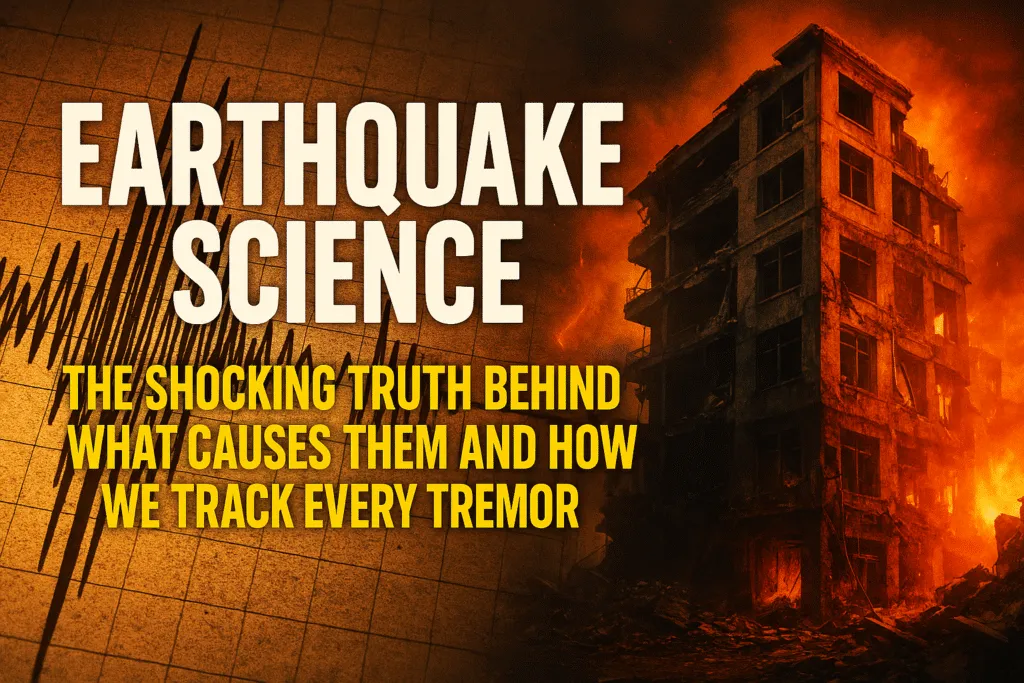Introduction: Understanding Earthquakes
Earthquakes are natural events that have fascinated and terrified humans for centuries. They occur when the Earth’s crust experiences sudden movements, releasing energy that travels as seismic waves. While many people think of earthquakes as purely destructive forces, they also play a key role in shaping the planet’s surface over time. Understanding how earthquakes happen and their potential impact is essential for both safety and scientific study.
Most earthquakes are caused by the movement of tectonic plates, the large slabs of rock that make up the Earth’s surface. These plates constantly shift, sometimes colliding, sliding past one another, or moving apart. When the stress between these plates exceeds a certain limit, it is released as an earthquake. Some earthquakes are triggered by volcanic activity or human actions, such as mining and construction, but the majority occur naturally along plate boundaries.
Measuring an earthquake is important for assessing its strength and potential damage. Scientists use seismographs to record the vibrations produced during an earthquake, which helps determine its magnitude. The magnitude gives an estimate of the energy released, while the intensity measures the impact on people, buildings, and the environment. Together, these measurements provide a comprehensive understanding of an earthquake’s effects and help authorities plan for disaster management.
Living in areas prone to earthquakes requires awareness and preparation. Simple steps like securing heavy furniture, creating emergency plans, and staying informed about early warning systems can significantly reduce risks. While earthquakes cannot be predicted with exact timing, understanding their causes and effects helps communities stay safer. Continuous research and technology improvements are enhancing our ability to detect, measure, and respond to earthquakes, making it possible to protect lives and minimize property damage.
Causes of Earthquakes
Earthquakes are powerful natural events that can strike without warning, causing significant damage and altering landscapes. Understanding the causes of earthquakes is essential for both scientific study and public safety. While they are often associated with sudden destruction, earthquakes are primarily a result of the dynamic nature of the Earth’s crust and its constant movement. The main causes can be divided into tectonic, volcanic, human-induced, and other natural factors.
Tectonic Plate Movements
The majority of earthquakes are caused by tectonic plate movements. The Earth’s outer shell, known as the crust, is divided into several large and small plates that float on the semi-fluid layer of the mantle. These plates are in constant motion, albeit very slowly, shifting only a few centimeters per year in most cases. When these plates interact at their boundaries, stress builds up. Over time, if the stress exceeds the strength of the rocks, it is released as seismic energy, resulting in an earthquake.
There are three main types of plate interactions that can trigger earthquakes. At convergent boundaries, plates collide, often creating powerful quakes and volcanic activity. Transform boundaries, where plates slide past each other horizontally, can cause shear stress, resulting in significant earthquakes such as those observed along the San Andreas Fault in California. Divergent boundaries, where plates move apart, also generate earthquakes, though they are usually less intense. Understanding these movements helps scientists identify high-risk earthquake zones and prepare communities accordingly.
Volcanic Activity
Volcanic activity is another important cause of earthquakes. As magma rises toward the Earth’s surface, it can create pressure on surrounding rocks, causing them to crack and shift. These volcanic earthquakes are often smaller than tectonic earthquakes but can serve as warning signs of an impending eruption. Volcanic regions, such as those along the Pacific Ring of Fire, experience frequent seismic activity due to this combination of magma movement and tectonic stress. Monitoring volcanic earthquakes is crucial for early warning systems to prevent loss of life and property.
Human Activities
Human-induced earthquakes, though less common than natural ones, are becoming increasingly significant due to industrial activities. Mining, large-scale construction, and reservoir-induced seismicity from dams can all alter underground pressures and trigger seismic events. Hydraulic fracturing, or fracking, has also been linked to minor earthquakes in some regions, as the process injects high-pressure fluids into rock layers, causing shifts. While these quakes are usually smaller, they highlight the importance of considering human impact when assessing earthquake risks.
Other Natural Causes
In addition to tectonic and volcanic activity, other natural causes can lead to earthquakes. Landslides, rock collapses, and even large meteorite impacts can generate seismic waves. While these events are less frequent and typically localized, they demonstrate that earthquakes are not solely restricted to plate boundaries. Understanding these rare causes is part of comprehensive earthquake research, helping scientists anticipate and mitigate unusual seismic events.
How Earthquakes Are Measured
Measuring earthquakes is essential for understanding their power, predicting potential damage, and improving safety measures. While earthquakes may feel sudden and unpredictable to people experiencing them, scientists have developed several tools and methods to quantify their strength and impact. Accurate measurement allows authorities to respond quickly, inform the public, and design infrastructure to withstand seismic events. The main aspects of earthquake measurement include magnitude, intensity, and modern monitoring techniques.
Magnitude
Magnitude is one of the primary ways to measure an earthquake, representing the total energy released at its source. This is usually determined using instruments called seismographs, which detect ground vibrations caused by seismic waves. The most well-known scale for measuring magnitude is the Richter scale, developed in the 1930s. Each increase of one point on the Richter scale represents a tenfold increase in the amplitude of seismic waves and roughly 32 times more energy released. For example, a magnitude 7 earthquake releases more than thirty times the energy of a magnitude 6 quake.
Another commonly used scale is the Moment Magnitude Scale (Mw), which is considered more accurate for larger earthquakes. While the Richter scale is useful for smaller, local earthquakes, the Moment Magnitude Scale calculates energy released based on the area of the fault rupture, the amount of slip, and the stiffness of the surrounding rocks. Scientists prefer this scale for modern earthquake measurement because it provides a more consistent estimate of energy across different types of earthquakes worldwide.
Intensity
While magnitude measures energy release, intensity focuses on the effects of an earthquake on people, structures, and the environment. The Modified Mercalli Intensity (MMI) scale is widely used to assess intensity, ranging from I, which is not felt, to XII, indicating total destruction. Intensity depends on several factors, including the earthquake’s depth, distance from the epicenter, local geology, and building quality.
For example, a moderate earthquake may cause only slight shaking in rural areas but significant structural damage in densely populated cities with older buildings. Mapping earthquake intensity helps engineers and urban planners design safer buildings, establish emergency response strategies, and identify areas most at risk. Unlike magnitude, which is a single value for an earthquake, intensity can vary widely depending on location.
Modern Techniques
Advancements in technology have greatly improved earthquake measurement and monitoring. Digital seismometers can detect even the smallest tremors, and global networks of these instruments allow scientists to triangulate the location and depth of earthquakes accurately. GPS and satellite-based monitoring systems also measure slow crustal movements, helping identify stress accumulation along faults before an earthquake occurs.
Early warning systems, especially in earthquake-prone countries like Japan and Mexico, use real-time data from these networks to alert people seconds to minutes before shaking starts. While this may not prevent the earthquake itself, it allows individuals and organizations to take immediate safety measures, such as stopping trains, shutting down industrial machinery, and moving to safe locations.
Conclusion
Earthquakes are powerful natural events that showcase the dynamic forces beneath the Earth’s surface. They can occur due to tectonic plate movements, volcanic activity, human activities, and other natural causes. Understanding these triggers helps scientists identify areas at higher risk.
Measuring earthquakes through magnitude and intensity, along with modern monitoring technologies, provides valuable insights into their strength and impact. These measurements help authorities plan safety measures and design resilient infrastructure.
Although predicting the exact timing of an earthquake is still impossible, advances in seismology and early warning systems allow communities to prepare better. Awareness and preparedness are key to minimizing damage and protecting lives.
By learning about why earthquakes happen and how they are measured, we can build safer communities and develop a deeper understanding of the dynamic planet we live on.
Also Read: BJP Names CP Radhakrishnan as NDA Candidate for Vice President.
FAQs
Can earthquakes be predicted?
Currently, scientists cannot predict the exact time and location of an earthquake. While they can identify high-risk zones and monitor stress along faults, the sudden release of energy that causes an earthquake remains unpredictable.
What is the difference between magnitude and intensity?
Magnitude measures the energy released during an earthquake, while intensity describes the effects on people, buildings, and the environment. Magnitude is a single value, but intensity can vary depending on location and local conditions.
Why do some areas experience more earthquakes than others?
Regions near tectonic plate boundaries, such as Japan, Indonesia, and California, experience more frequent earthquakes. Areas with volcanic activity or certain geological conditions are also more prone to seismic events.
Can human activities cause earthquakes?
Yes, activities like mining, large-scale construction, hydraulic fracturing (fracking), and reservoir creation can trigger small to moderate earthquakes by altering underground stress and pressure.
How do early warning systems help during earthquakes?
Early warning systems use real-time seismic data to alert people seconds to minutes before shaking begins. While they cannot stop an earthquake, these systems give valuable time to take safety measures, such as moving to a safe location or shutting down equipment.





























